Do Hawks Eat Bluebirds? All You Need To Know!
Bluebirds are a well-known and iconic songbird species, distinguished by their stunning blue plumage and sweet melodic songs. Many backyard bird watchers and bird enthusiasts are drawn to these delightful birds and work hard to attract them to their yards. However, one common source of concern is the risk of hawk predation.
So, the question is, do hawks eat bluebirds? Yes, hawks do eat bluebirds. While bluebirds are not a primary food source for hawks, they can become prey in certain circumstances. Bluebird size and vulnerability can influence the likelihood of hawk predation.
Understanding this hawks-bluebird relationship can be educational and fascinating if you are a bird enthusiast or simply curious about the natural world. This article will explore hawk-bluebird relationships and factors influencing hawk predation on bluebirds, among other topics.
Types Of Hawks That Feed On Bluebirds
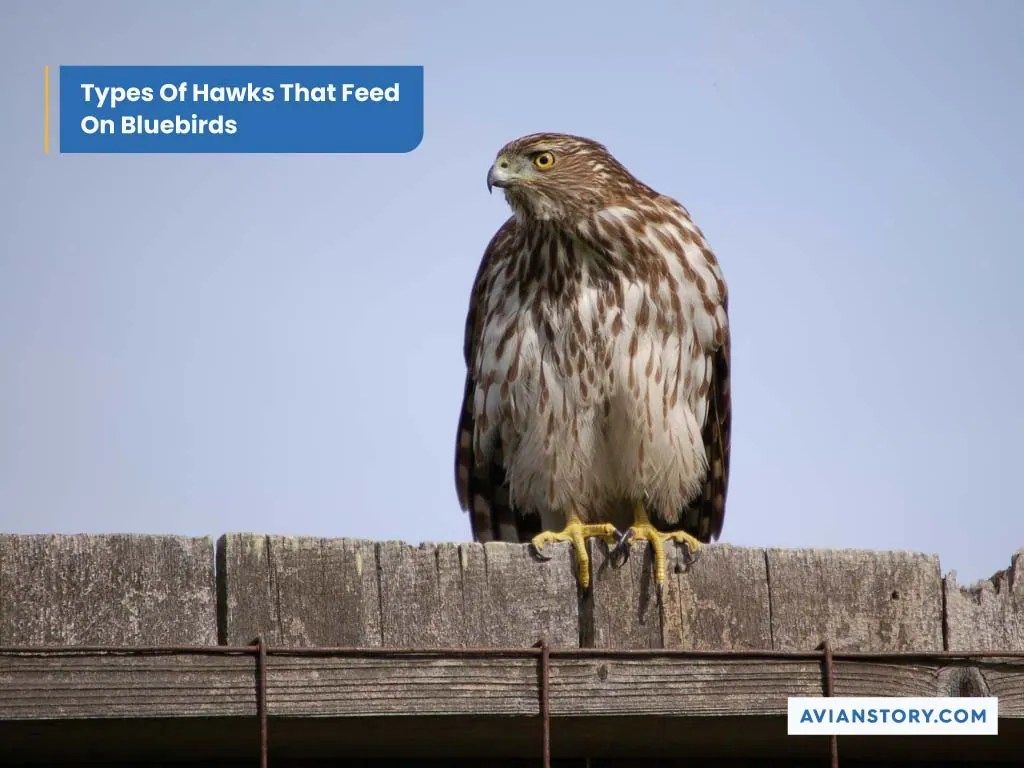
Several types of hawks are known to prey on bluebirds. These include:
- Cooper’s Hawk: These are medium-sized birds of prey known for their agility and quick flight. They are known to prey on various birds, including bluebirds. They have a distinctive slate-gray back, rusty-red breast, and vertical streaking on the chest. They also have a dark cap and bright yellow eyes.
- Sharp-shinned Hawk: This is a small hawk with a slim body, short, broad wings, and a long, squared tail. They also have a dark gray back and a white chest with vertical reddish-brown streaks. They are known for their fast flight and are skilled at capturing small, agile prey like bluebirds.
- Red-tailed Hawk: This hawk is a huge bird of prey distinguished by its striking red tail feathers, broad wings, and huge size. They also have a reddish-brown back and a pale, mottled breast. Red-tailed hawks will eat whatever they can get their hands on.
- Northern Goshawk: They are known for their fierce hunting abilities and can take down prey as large as a rabbit or hare.
They are distinguished by their white chest, brown horizontal streaks, and a dark cap on their head. While bluebirds are not a primary food source for Northern Goshawks, they can be taken as prey in certain circumstances.
Do Hawks Eat Bluebird Eggs?
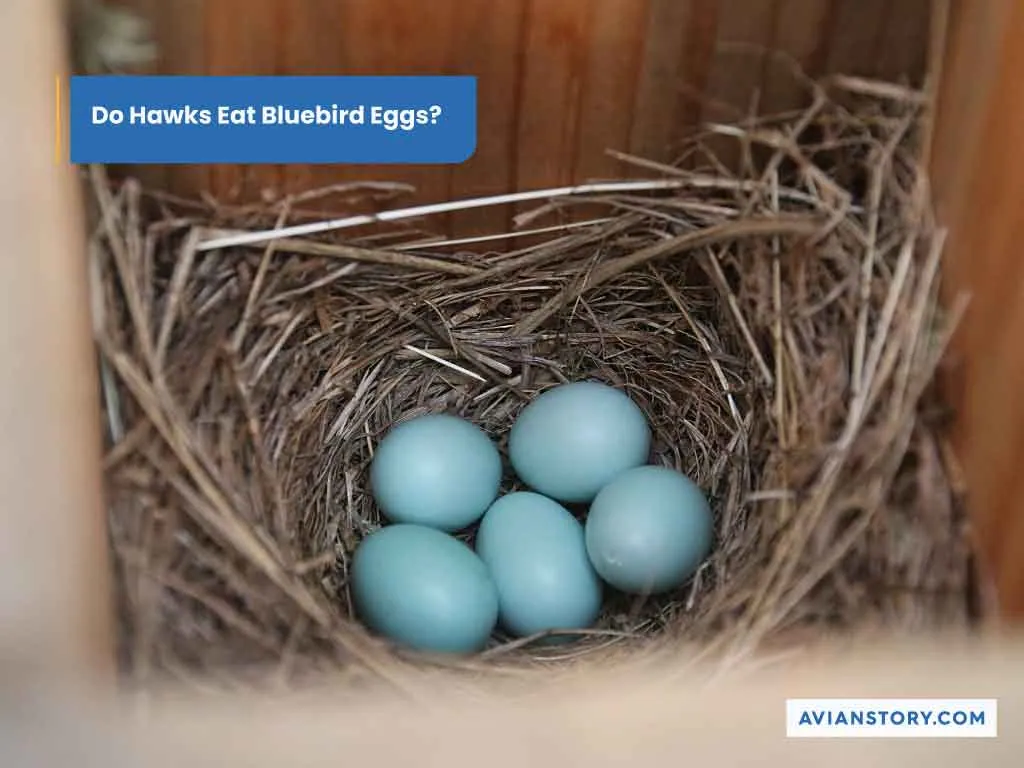
Yes, hawks do eat bluebird eggs. Bluebirds are cavity-nesting birds, which means they build their nests in cavities of trees or nest boxes. The eggs and young inside the nest are vulnerable to predation by various predators, including hawks.
Some hawks, such as the Cooper’s Hawk and Sharp-shinned Hawk, are known to raid nests and consume eggs and young birds. These agile hawks can maneuver through small openings, quickly accessing bluebird nests.
Bluebird Species Overview

Bluebirds are a type of medium-sized bird in the Thrush family. Bluebirds primarily feed on insects, including beetles, caterpillars, grasshoppers, and spiders. They also eat fruits such as berries and grapes when insects are scarce.
In North America, there are three species of bluebirds, each with its own distinct characteristics and habitat.
In this section, we will discuss the three bluebird species: the Eastern Bluebird (Sialia sialis), the Western Bluebird (Sialia mexicana), and the Mountain Bluebird (Sialia currucoides).
Eastern Bluebird
The Eastern Bluebird is the most common of the three species and can be found throughout the eastern half of North America. They are small birds, about 6.5 inches long, with bright blue plumage, a rusty red breast, and a white belly.
Eastern Bluebirds are cavity nesters who prefer open habitats such as fields, meadows, and orchards. Their diet consists primarily of insects but will consume berries and other fruits.
Western Bluebird
The Western Bluebird is found in the western half of North America, from Alaska to Mexico. They are slightly larger than the Eastern Bluebird, measuring around 7 inches in length.
They are distinguished by their blue upperparts, rusty red breast, and blue-gray throat. Western Bluebirds prefer open habitats such as grasslands and pastures and nest in cavities.
Mountain Bluebird
The Mountain Bluebird can be found in the western half of North America, from Alaska to Mexico, but it is primarily a Rocky Mountain bird. They are the largest of the three species, measuring around 7.5 inches in length.
They are easily identified by their bright blue plumage and white belly. Like the other two species, Mountain Bluebirds do not have rusty red breast feathers.
Mountain Bluebirds also prefer open habitats, but they are typically found at higher elevations in meadows and open woodlands.
Factors That Influence Hawk Predation On Bluebirds
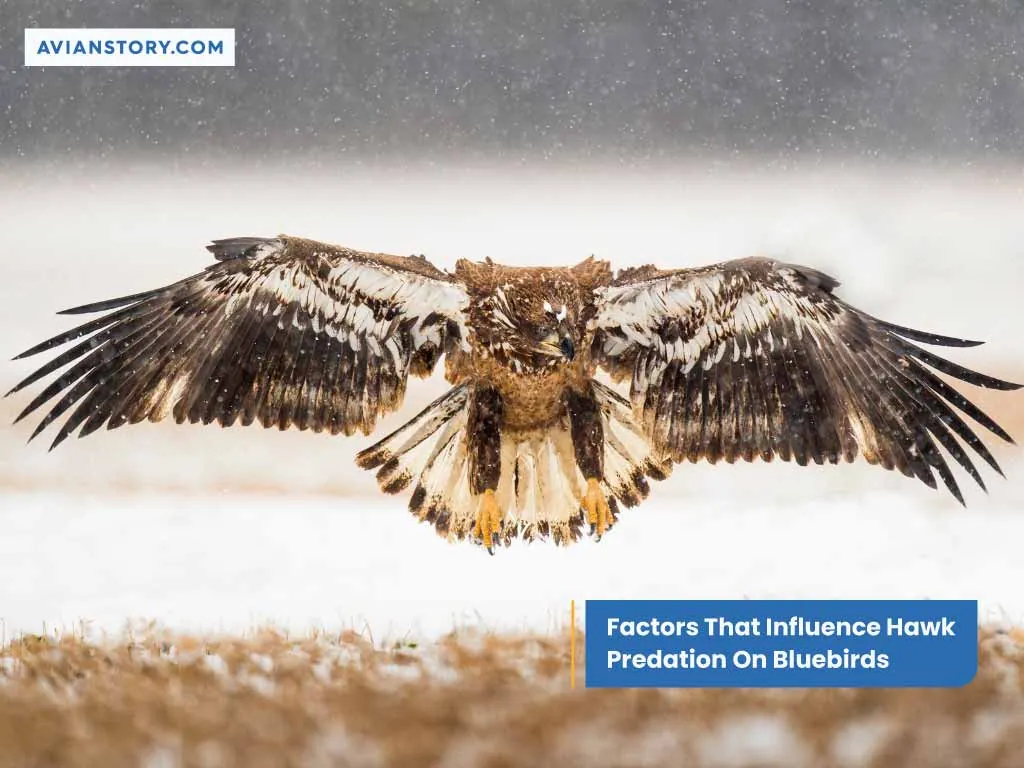
Several factors can influence the likelihood of predation by hawks on bluebirds. These factors include:
Nest location
Nest boxes near trees or other structures that provide predator cover can increase predation risk. Furthermore, nests in open areas with little cover can make bluebirds more vulnerable to predation.
Time of year
Bluebirds are more vulnerable to predation during the nesting season, which typically lasts from March to August. This is because they are actively nesting and raising their young.
Furthermore, bluebirds may be more vulnerable to predation during migration because they are in unfamiliar areas and may be more exposed to predators.
Bluebird behavior
More cautious and vigilant bluebirds may be able to detect and avoid potential predators, lowering their risk of predation. On the other hand, bluebirds that are bold or more curious may approach predators more frequently, increasing their risk of predation.
Hawk behavior
Hawks specializing in hunting birds, such as the Cooper’s Hawk and Sharp-shinned Hawk, may prey on bluebirds more frequently. Furthermore, hawks more opportunistic and willing to pursue in open areas may prey on bluebirds.
Availability of alternative prey
Hawks may be less likely to target bluebirds as a food source if they can access other prey species. If other prey is scarce, hawks may turn to bluebirds as an easy target.
Geographic distribution and habitat overlap
Bluebirds may be more likely to be targeted by hawks in areas where bluebirds and hawks share a high degree of habitat overlap. Similarly, hawks may be more likely to target bluebirds as a food source in more abundant areas.
In addition, bluebirds living in areas with limited food sources may be more vulnerable to predation because they are more visible to predators when searching for food.
Hunting Techniques For Capturing Bluebirds
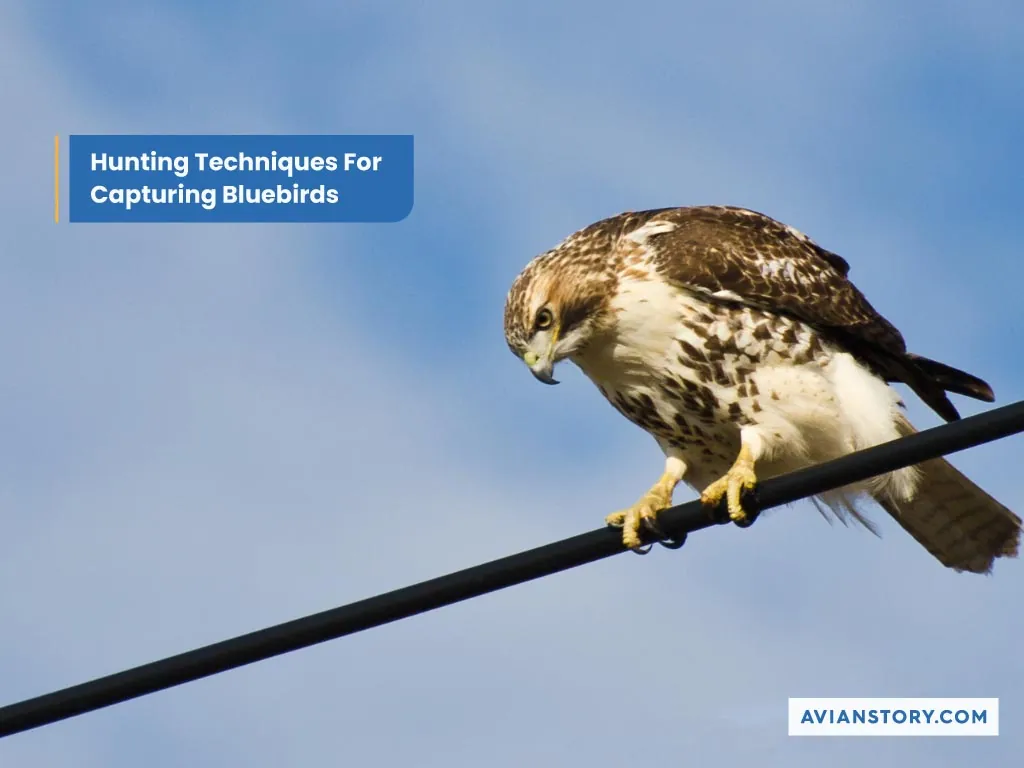
Hawks have developed a range of hunting techniques to catch and capture bluebirds. These techniques include:
Perch Hunting
Many hawks, including Cooper’s and Sharp-shinned Hawks, use perch hunting to catch bluebirds. These hawks will perch on a tree branch or fence post and wait for the bluebird to come within striking distance.
When they spot a bluebird, they swoop and try to catch it. The key to success in perch hunting is choosing the right location to perch, where prey is likely to pass by.
Aerial Attacks
Hawks will hover or soar above an open area, such as a field or meadow, scanning for potential prey. When they spot a bluebird, they dive quickly and catch it.
Aerial attacks necessitate a high level of skill and agility, as the hawk must precisely time its dive and adjust its speed and angle to catch its prey.
Cooperative Hunting
Some hawks, such as Northern Goshawks, have been observed hunting bluebirds in groups. In this technique, two or more hawks hunt and catch their prey together. One hawk will flush the prey out of hiding, while the other will wait for it to take flight before swooping down to catch it.
Adaptations For Capturing And Consuming Bluebirds
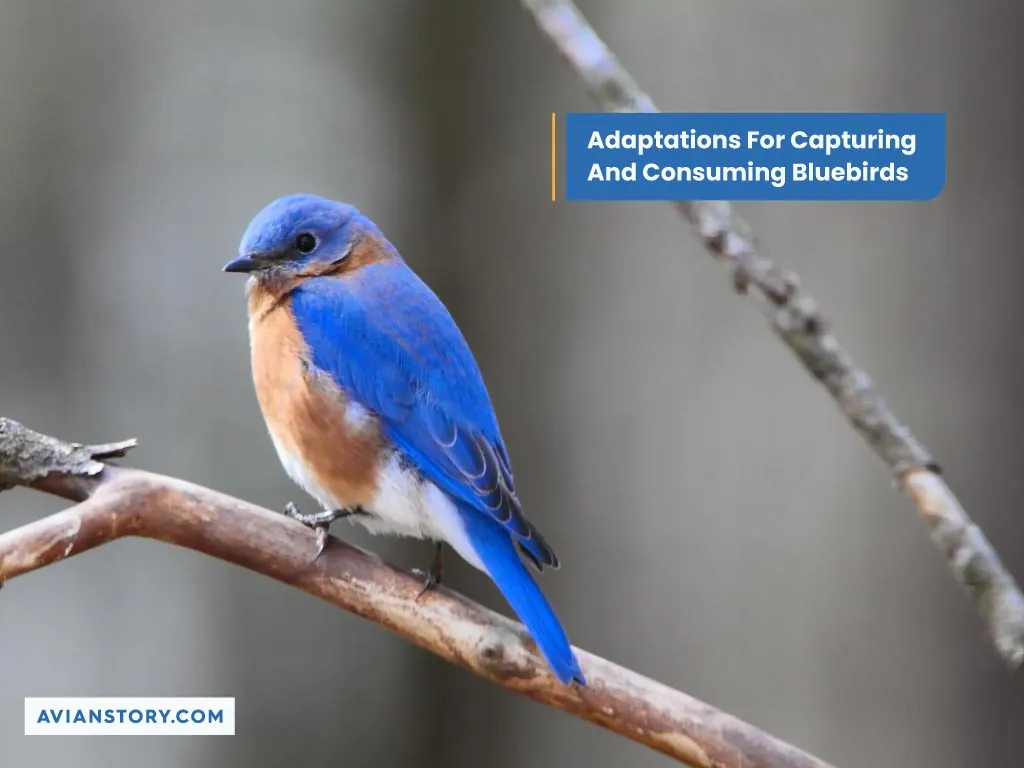
Here are some physical and behavioral adaptations of bluebirds in capturing bluebirds.
Physical Adaptations:
- Talons: Hawks have sharp, curved talons on their feet adapted to capture prey. These talons are powerful and capable of gripping prey tightly. When a hawk captures a bluebird, it uses its talons to hold onto it while it eats.
- Beak: Hawks have sharp, hooked beaks designed for shredding flesh. The hawk uses its beak to cut out portions of flesh to ingest. The beak is also employed to remove feathers and other non-edible components of the prey.
- Vision: Hawks have exceptional eyesight to spot potential prey from great distances. Their eyes are adapted for detecting movement and distinguishing colors, making locating bluebirds in their habitat easier.
Behavioral Adaptations:
- Stealth and surprise: Hawks often hide in trees or other locations, waiting for prey to come within striking distance. Once they spot a bluebird, they will swoop down with lightning speed and capture it before it has time to react.
- Patience: Hawks are patient predators who can wait for their prey for a long time. When hunting bluebirds, hawks will frequently perch at a position and wait for the bluebird to get within range. Bluebirds can be elusive and challenging to catch, so this demands a lot of patience.
- Memory: Hawks have an excellent memory, which allows them to remember the location of prey-rich areas and individual bluebird nests. They can also recall past hunting successes and failures, using that information to improve their hunting techniques.
Impact Of Bluebird Consumption On Ecosystems
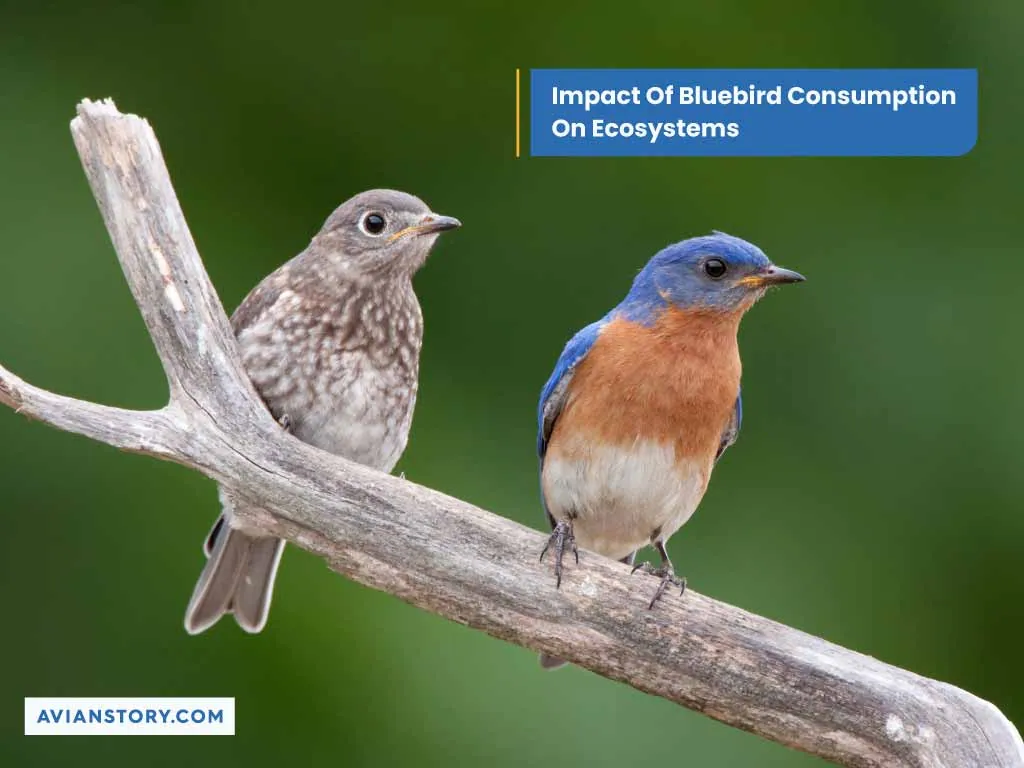
Hawks play a crucial role in maintaining balance and diversity in ecosystems. However, the consumption of bluebirds by hawks can significantly impact the ecosystem. They include:
1. Negative Impact On Bluebird Populations
Hawks eating bluebirds can harm their populations, especially if the hawks prey on adult bluebirds during the breeding season.
2. Impact On Food Webs
The consumption of bluebirds by hawks can affect the entire food web, as bluebirds are connected to other organisms through their role as seed dispersers and pollinators.
Changes in bluebird populations can affect the abundance and distribution of other species, ultimately impacting the ecosystem’s overall health.
3. Impact On Hawk Populations
The availability of bluebirds as prey can also impact hawk populations. If bluebirds are overhunted, hawks may struggle to find enough food to survive and reproduce, declining their populations.
4. Ecological Importance
Bluebirds are essential contributors to ecosystems. They aid in the spread of plant species and the conservation of biodiversity by dispersing seeds. They are also important pollinators, helping reproduce many plant species. Hawks can influence these ecological processes by eating bluebirds.
Human Impact On Hawks’ Bluebird Predation
Here are some ways that humans can affect hawks’ predation of bluebirds:
1. Habitat Loss
This happens due to human activities such as urbanization, agriculture, and deforestation. As bluebirds lose their habitat, their populations decrease, reducing prey availability for hawks. This can lead to increased competition among hawks for limited prey resources.
2. Pesticide Use
Pesticide use can impact bluebird populations by reducing the availability of insects, an important food source for bluebirds.
Pesticides can also indirectly affect hawk populations by reducing the availability of prey for them. Pesticides can also accumulate in the tissues of bluebirds and hawks, causing long-term health effects.
3. Climate Change
Climate change can impact bluebirds and hawks by altering their habitats, decreasing prey availability, and altering migration patterns. These changes can affect the timing and duration of the breeding season, affecting bluebird success and prey availability for hawks.
Here are other related questions about hawks and bluebirds.
Do hawks eat blue jays?
Yes, hawks sometimes prey on blue jays, especially during the winter when food is scarce.
What do hawks eat?
The exact diet of a hawk will depend on the species and the habitat in which it lives, but everyday prey items include small mammals such as rodents, rabbits, and squirrels, as well as birds, reptiles, and insects.
How can I tell if a hawk is targeting my bluebirds?
If you notice a hawk circling or perching near your bluebird nesting site, it may target your bluebirds. Other signs that a hawk may target your bluebirds include missing birds, feathers, or eggshells.
Conclusion
Hawks are natural predators of bluebirds and can significantly threaten their survival. However, by understanding the factors that influence hawk predation and taking steps to protect bluebirds, it is possible to reduce the risk of predation and ensure the survival of these bluebirds.
Hawk predation on bluebirds can be influenced by factors such as the availability of alternative prey and bluebird behavior. Bluebirds can be protected from hawks using various techniques, including providing cover and protective netting and installing predator guards.
It is also important to note that hawks are not the only predators of bluebirds. Other animals, such as snakes, raccoons, and house wrens, can also threaten bluebirds and their young. With the proper knowledge, tools, and strategies, we can all play a role in preserving the beauty and diversity of bluebirds.
Resource:
